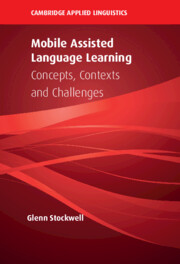Book contents
- Mobile Assisted Language Learning
- The Cambridge Applied Linguistics Series
- Mobile Assisted Language Learning
- Copyright page
- Dedication
- Contents
- Figures
- Tables
- Acknowledgements
- Abbreviations
- 1 Introduction
- 2 Fundamental Considerations of Teaching with Mobile Technologies
- 3 Shifting Paradigms in Language Learning and Teaching
- 4 Research Considerations in MALL
- 5 Theory in MALL
- 6 Physical, Psychosocial and Pedagogical Issues
- 7 The Learner in MALL
- 8 Designing MALL Environments
- 9 Concepts, Contexts and Challenges in MALL
- Glossary
- References
- Index
1 - Introduction
Published online by Cambridge University Press: 23 December 2021
- Mobile Assisted Language Learning
- The Cambridge Applied Linguistics Series
- Mobile Assisted Language Learning
- Copyright page
- Dedication
- Contents
- Figures
- Tables
- Acknowledgements
- Abbreviations
- 1 Introduction
- 2 Fundamental Considerations of Teaching with Mobile Technologies
- 3 Shifting Paradigms in Language Learning and Teaching
- 4 Research Considerations in MALL
- 5 Theory in MALL
- 6 Physical, Psychosocial and Pedagogical Issues
- 7 The Learner in MALL
- 8 Designing MALL Environments
- 9 Concepts, Contexts and Challenges in MALL
- Glossary
- References
- Index
Summary
This chapter lays the foundation for the issues that are raised in the book through positioning technology in language teaching and learning practice. It begins by exploring the different controversies associated with technology in education and then goes on to discuss the nature of mobile-assisted language learning in terms of the different technologies and the different ways that these technologies might be used. The complexities involved in defining MALL are also explained given the wide range of devices that are available, ranging from laptops and tablets to mobile phones and wearable devices. The chapter then seeks to clear up some of the myths associated with what MALL is and draws parallels with CALL. The remainder of the chapter is dedicated to providing an overview of each of the chapters of the book.
Information
- Type
- Chapter
- Information
- Mobile Assisted Language LearningConcepts, Contexts and Challenges, pp. 1 - 20Publisher: Cambridge University PressPrint publication year: 2022
